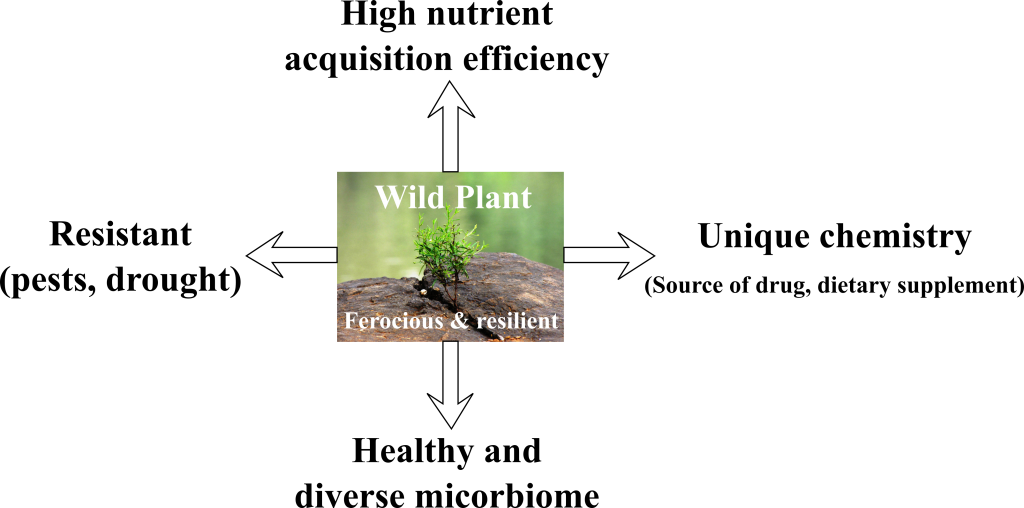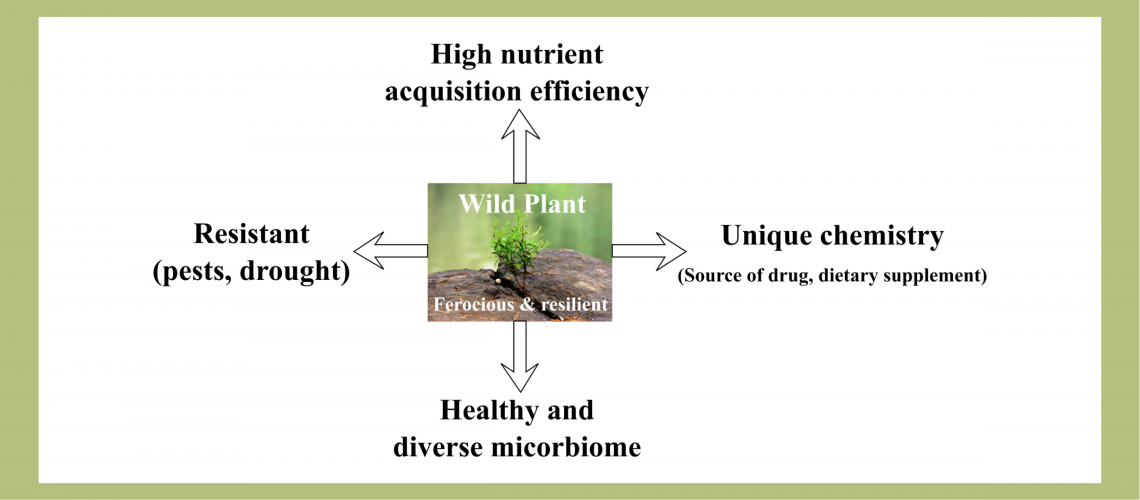Guest Post By Janak Joshi, 2020-2021 Sustainability Leadership Fellow and Postdoctoral Fellow in the Department of Horticulture and Landscape Architecture at Colorado State University
Natural, ferocious, hard, and resilient are all characteristics of the wild. Current civilization and all its ingredients can be traced back to its wild relative. Through centuries of investment, brainstorming, and dedication the world has explored all the ways to efficiently domesticate and exploit plants from their wild niches. This activity has addressed our global food requirement, however, resulted in minimized diversity, ferociousness, and resilience of the domesticated plants. Loss of these characteristics in domesticated plants and crops puts them at risk from threats within their ecosystem by drought, diseases, and pests. As a result, crop loss has occurred on large scales causing food scarcity and ultimately threatening human nutrition and life. Such incidences have been recorded in past as unforgettable famines and economic ruins: Iris feminine-1846 (caused by late blight disease of potato), Bengal famine-1943, and North Korean famine-1994 (caused by drought), economic ruins for wine industry 1865 (caused by downy mildew of grapes) and banana industry 1950 (caused by Panama wilt of banana), and many more. Scientists and researchers are now trying hard to incorporate wild characteristics into cultivated ones to avoid future catastrophes. Besides agriculture, nutritional supplements, medicines, and pesticides have become the inevitable components of our daily life. Majority of these chemical supplements have been identified, isolated, and derived from wild plants. Therefore, scientists are also investigating the potentials of wild plants in therapeutics. Altogether, solutions for current and future crises in food, and nutrition has led our journey back to wild.
Wild plants as source of resistance. Human exploitation of natural resources has resulted in accelerated climate change, ecological imbalance, and pest resistance & outbreaks that affect global food production (Deutsch et al., 2018). Of several factors affecting plant yields, pests and diseases account for significant yield loss ranging from complete crop loss in some geographical locations to 10-40% on the global scale (J. Conrow 2019; P. Kan-Rice 2019). These statistics are disturbing, and with the changing climate and growth in the global population this massive volume of food loss is unsustainable. Many of the efforts to reduce crop loss utilize synthetic chemicals, biological control measures (i.e., introducing natural enemies of pathogens and natural plant products), and plant quarantine. These measures have limited success and dire environmental consequences. Development of crop varieties that are resistant to various diseases is a viable option to effectively control crop loss. The success of using resistant varieties, such as, cotton plants resistant to insects, tobacco plants resistant to tobacco mosaic virus, and potatoes resistant to blight disease has proved to be effective. Development of resistant varieties can be accomplished by incorporating desirable traits from wild plants, via breeding techniques, gene editing tools, or genetic engineering techniques.
Wild plants as a scaffold for new curative drugs and dietary supplements. Pathogens have exceptional ability to adapt and survive in challenging circumstances and as a result they have successfully overcome many of the synthetic chemicals used against them. Development of new antibiotics around effective natural scaffolds, which are backbone taken from wild plants and used to build compounds, with antimicrobial activity can be a potential solution to address increasing demands of drugs against pests. Traditional medicinal plants, present in wild, have therapeutic properties and are likely to provide new compounds against pathogens. This method has already been proved to be effective, as it has contributed production of more than one-third of all FDA-approved new molecular entities (Patridge et al., 2016). Besides medicinal plants, other wild plants have abundance of metabolites that have negative impacts on herbivores, and pests (Gupta and Birdi, 2017; Hussein and El-Anssary, 2018; Joshi et al., 2021). These metabolites can be purified, studied, and their efficacy can be improved by altering their functional group. Modification of plant metabolites have been reported to be a novel approach for the discovery of new drugs (Yao et la., 2016). Thus, wild plants and their metabolites can be a good antidote against pathogens or serve as a backbone to develop curative chemicals against pathogens. On the other hand, wild plants also have curing abilities for multiple health disorders; showing antioxidant, antidiabetic, antibacterial and anticancer properties (Shaheen et al., 2017). Thus, studies have been done to study microelements in wild plants aiming to discover plant molecules which can prevent, control, or cure human health disorders (Tan and Norhaizan, 2018).

Wild plants as a source of healthy microbiome. Microbiome is a community of microorganisms that inhabits a particular environment. Plants rely on microbiomes for many life-support functions like nutrient acquisition and protection from pests and diseases (Perez-Jaramillo et al., 2018). Microbiomes are majorly affected by plants and the environment; however, plants play active role in recruiting microorganisms in their surroundings which is believed to be driven by their root exudates such as organic acids, amino acids, fatty acids, phenolics, sugars, sterols, nucleotides, and vitamins. The ability of wild plants to efficiently exploit their microbiome was overlooked during domestication, and as a result domesticated plants have lost their ability to recruit microorganisms to their benefit. Therefore, researchers are turning to the wild plants to study their microbiome and understand its genetic regulation (Jaiswal et al., 2020). Furthermore, some studies are now analyzing the microbiome in of healthy wild plant systems and are recommending microbial mixtures for improved yield and disease resistance.
Wild plant as models for nutrient acquisition in low nutrient environment.
Plants are the powerhouses of our ecosystem and require bioavailable nutrients for growth and production. The major source of nutrition for a plant is the soil around it. The constant erosion and exploitation of the soil for domesticated crops is leading to a declining health and productivity for these crops in many parts of the world. Consequently, agricultural land in many parts of the world has been deserted. Though the nutrient profile in soil can be corrected by applying fertilizer to the soil, it comes with the consequences of ground water contamination and heavy expenses. However, wild plants are persistent in their ability to grow and flourish in nutrient deprived conditions, proving to be efficient nutrient acquisitors. This capability in wild plants allows possible improvement in domesticated crops. There are studies to currently underway to explore, understand, and utilize the genetic control in nutrient acquisition of plants (Zhu et al., 2002, Pilbeam D.J., 2015). In this route scientists have successfully developed plants with high nutrient (nitrogen, phosphorus, and potassium) use efficiency, and are also working on improving root architecture for efficient uptake of immobile nutrients.
Altogether, nature has vast resources in wild forms, which need to be explored and utilized. Scientists are diving into wild gene pools and hunting for genes and chemicals that can solve our current crop, nutritional, and health crises, leading our journey back to wild.
References
Conrow J. New crop loss study underscores urgent need for resistant varieties. In Cornell Alliance for Science February 20, 2019. https://allianceforscience.cornell.edu/blog/2019/02/new-crop-loss-study-underscores-urgent-need-resistant-varieties.
Deutsch C.A., Tewksbury J.J, Tigchelaar M., Battisti D.S, Merrill S.C, Huey R.B., and Naylor R.L. (2018). Increase in crop to insect pests in a warming climate. Science, 361: 916-919.
Gupta P.D., and Birdi T.J. (2017). Development of botanicals to combat antibiotic resistance. Journal of Ayurveda and Integrative Medicine. 8:266-275.
Hussein R.A., and El-Anssary (2018). Plant Secondary Metabolites: The key drivers of the pharmacological action of medicinal plants. Herbal Medicine, IntechOpen, DOI: 10.5772/intechopen.76139.
Jaiswal A.K., Mengiste T.D., Myers J.R., Egel D.S., and Hoagland L.A. (2016). Tomato domestication attenuated responsiveness to a beneficial soil microbe for plant growth promotion and induction of systemic resistance to foliar pathogens. Frontiers in Microbiology. https://doi.org/10.3389/fmicb.2020.604566
Joshi J.R., Yao L., Charkowski A.O., and Heuberger A. (2021). Metabolites from wild potatoes inhibit virulence factors of the soft rot and black leg pathogen Pectobacterium brasiliense. Molecular Plant Microbe Interactions 34: 100-109.
Kan-Rice P. Pests and disease cause worldwide damage to crops. In California Ag Today February 11, 2019. https://californiaagtoday.com/pests-diseases-cause-worldwide-damage-crops/
Patridge E., Gareiss P., Kinch M.S., and Hoyer D. (2016). An analysis of FDA-approved drugs: natural products and their derivatives. Drug Discovery Today. 21:204-207.
Pilbeam D.J. (2015). Breeding crops for improved mineral nutrition under climate change conditions. Journal of Experimental Botany. 66: 3511-3521. https://doi.org/10.1093/jxb/eru539
Perez-Jaramillo J.E., Carrion V. C., de Hollander M., and Raaijmakers J.M. (2018). The wild side of plant microbiomes. Microbiome. 143: https://doi.org/10.1186/s40168-018-0519-z.
Shaheen S., Ahmad M., Haroon N. (2017). Nutritional Contents and Analysis of Edible Wild Plants. In: Edible Wild Plants: An alternative approach to food security. Springer, Cham. https://doi.org/10.1007/978-3-319-63037-3_5
Tan B.L., Norhaizan M.E. (2018) Plant-derived compounds in cancer therapy: traditions of past and drugs of future. In: Akhtar M., Swamy M. (eds) Anticancer plants: Properties and Application. Springer, Singapore. https://doi.org/10.1007/978-981-10-8548-2_5
Yao H., Liu J., Xu S., Zhu Z., and Xu J. (2016). The structural modification of natural products for novel drug discovery. Expert Opinion on Drug Discovery 12: 121-140.
Zhu Y.G., Huang C., Howes N.K., Smith S.E. (2002). Breeding for low-nutrient environments. In: Adu-Gyamfi J.J. (eds) Food Security in Nutrient-Stressed Environments: Exploiting Plants’ Genetic Capabilities. Developments in Plant and Soil Sciences, vol 95. Springer, Dordrecht. https://doi.org/10.1007/978-94-017-1570-6_7






